Hazel Needham, Conrad Pilditch, Drew Lohrer, and Simon Thrush are scrutinising how the mud crab’s burrow fits into estuarine ecology.
PDF of this article (249 KB)
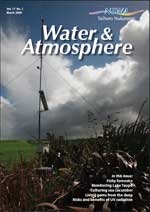
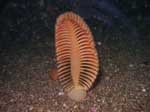
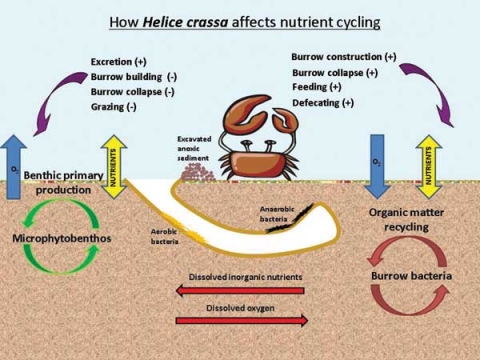
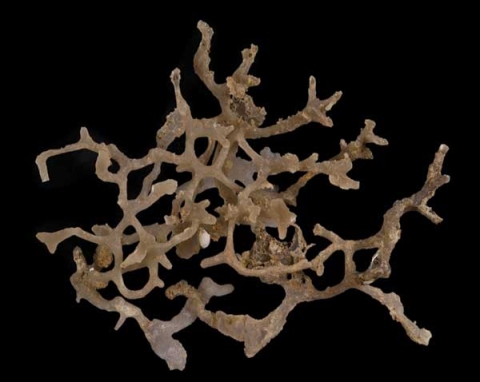
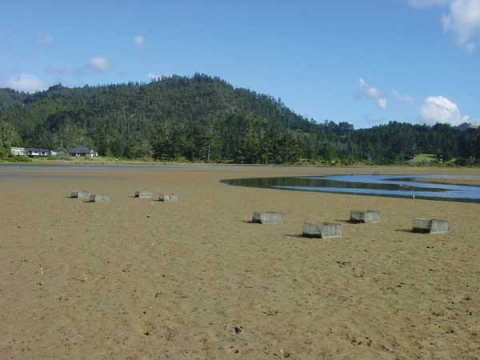
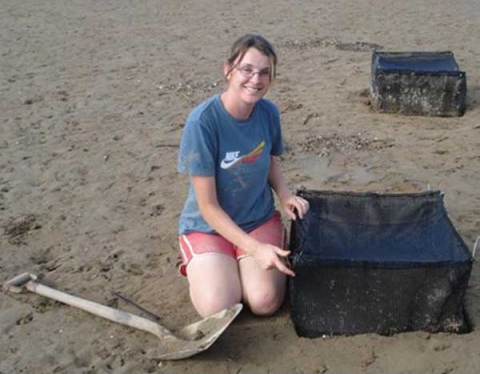
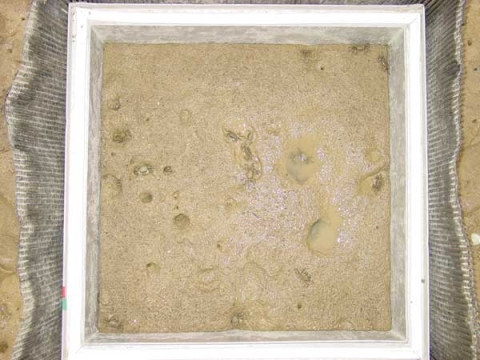
If you’ve ever strolled around any one of New Zealand’s 400 estuaries, you’re probably familiar with the obvious signs of mud crab activity. These critters are small (less than 2 cm wide), and are often found in high densities, evident from the multitude of burrow openings peppering the sediment surface. But what are these creatures doing and does it matter to the estuary as a whole if they are there or not?
The role of bioturbators
Organisms that displace sediments and mix particles when they create their burrows are known as ‘bioturbators’. A dominant bioturbator, such as the mud crab, engineers its environment’s physical and chemical habitat, in turn affecting the microbial communities living within it. Crab burrows increase the sediment surface area and provide greater potential for oxygen diffusion across the burrow wall, resulting in an increase in bacterial communities. Bacteria are important in breaking down organic material and recycling nutrients, which are either used within the burrow or exported into the waters of the estuary. Burrows are not permanent structures; during both their construction and collapse they introduce oxygen and particulate organic matter to deeper regions of sediment.
Organisms that displace sediments and mix particles when they create their burrows are known as ‘bioturbators’. A dominant bioturbator, such as the mud crab, engineers its environment’s physical and chemical habitat, in turn affecting the microbial communities living within it. Crab burrows increase the sediment surface area and provide greater potential for oxygen diffusion across the burrow wall, resulting in an increase in bacterial communities. Bacteria are important in breaking down organic material and recycling nutrients, which are either used within the burrow or exported into the waters of the estuary. Burrows are not permanent structures; during both their construction and collapse they introduce oxygen and particulate organic matter to deeper regions of sediment.
Caging conundrum
In summer 2008, we conducted experiments to assess how mud crab density affects nutrient exchange in both muddy and sandy sediments. We selected two sites in Tairua estuary on the Coromandel Peninsula for their high crab densities, differences in habitat type, yet close proximity to one another. As the mud crab is a highly mobile deposit feeder, the only way to control the numbers in our study was to completely cage off areas of these flats. We used mesh boxes, complete with lid and base, to isolate our experimental plots from the rest of the crab community and to enforce the participation of the Houdini-like mud crabs. These cages were bedded in to below typical burrowing depth and filled with the sieved, excavated sediment. We buried 16 cages at each of the two sites. After two weeks of re-establishment, we placed crabs in the cages in four different densities and again allowed everything to settle for two weeks before running our experiments.
Measuring nutrient fluxes
To measure the changes in nutrient concentrations over time (the nutrient flux), we deployed a benthic chamber in each of the 16 cages. These chambers encapsulate a known volume of water over the crab burrows on an incoming tide, enabling us to sample from the same water body at regular intervals until the tide retreats. Estuarine sediments support a fine layer of microscopic algae on the surface known as microphytes which use nutrients released from the sediments for growth as well as providing a food resource for the crabs and other organisms. To establish how microphyte communities are affected by the crabs, we measured nutrient flux during daylight when the microphytes photosynthesise and at night when they don’t. By sampling both day and night, we also ensured that the crab’s behavioural patterns were not altered. After a night of intense measurement, sleepdeprived scientists collected further information from the cages by making resin casts of the burrows to record their size and shape, and recorded microphyte density, sediment particle size, organic content of the sediments, and the diversity and density of other animals living around the crab burrows.
The story so far
The mud crab is an important agent in the cycling of nutrients in estuarine environments. In our study, crab density in both sandy and muddy sediments had a strong influence on ammonium and oxygen fluxes during both day and night. Microphyte numbers were lower in muddy sediments than in the sand and the more crabs the fewer microphytes, due to grazing pressures. However, the ability of the microphytes to fix oxygen increased with increasing crab density. We believe this is due to increased ammoniacal nitrogen though crab excretion, available for use by the microphytes. This example illustrates the complex relationships between a crab and its environment. We’re now working on further analyses to tease apart other interactions.
The wider view
We’re really only beginning to understand and value the ecosystem services derived from our estuaries, but it’s the complex ecological functions, as illustrated by the mud crab, that underpin these services. Due to a range of habitat and community types, estuaries can support a wide variety of services associated with, for example, productivity, water clarity, and biodiversity. The growing urbanisation of our coasts and estuaries, and intensive land use in estuarine catchments, put pressure on these ecosystems. Understanding the ecological functions that underpin ecosystem services helps us understand how good these systems are at processing the waste material we deliberately or inadvertently release into them. It also recognises the potential for change in the ecological values of estuaries as key species are lost and habitats are modified.
Environmental engineers
- When mud crabs dig their burrows in tidal flats, they change the local environment.
- The burrows introduce oxygen into the sediments, affecting the nutrient cycle and the amount of primary production.
- Cage experiments are measuring the extent to which mud crab activities support healthy estuaries.
Hazel Needham and Dr Conrad Pilditch are based at the University of Waikato; Dr Drew Lohrer and Dr Simon Thrush are benthic ecologists at NIWA in Hamilton. This article is based on work for Hazel’s PhD thesis project, funded through the FRST programme ‘Ecosystem-based Management of New Zealand’s Coastal and Oceanic Waters’.
